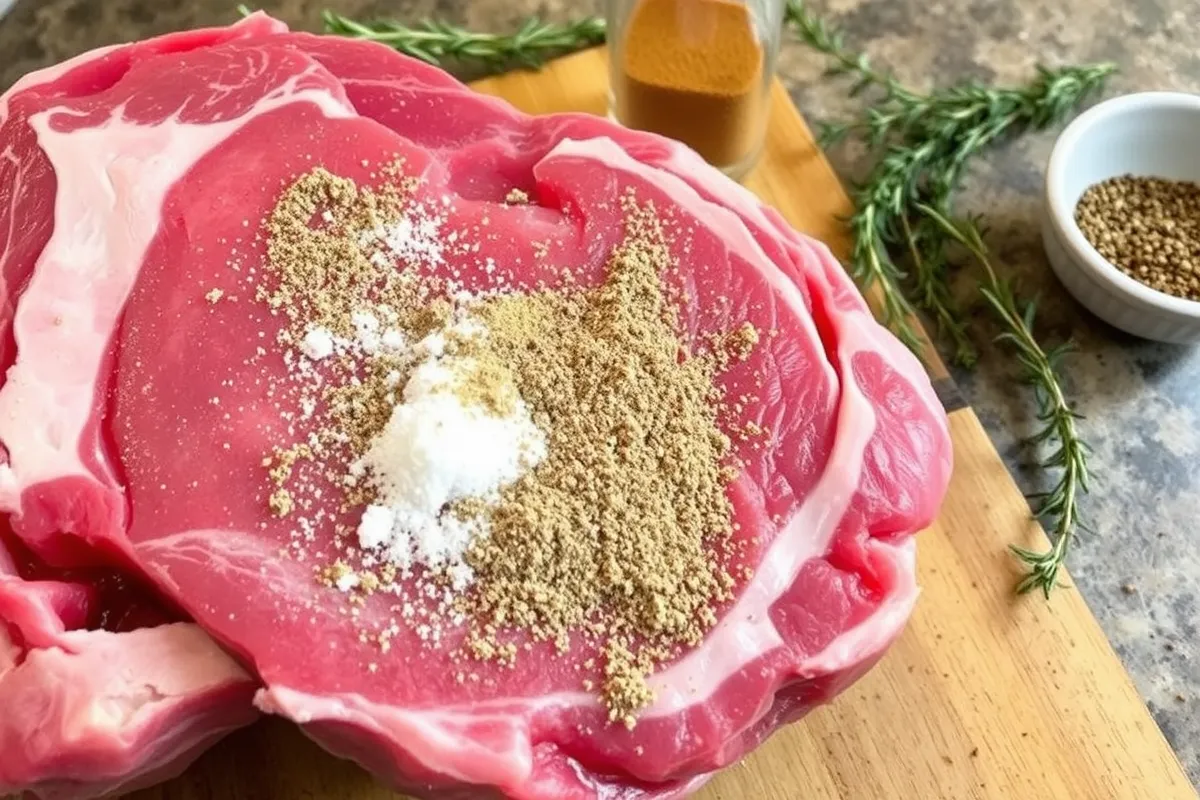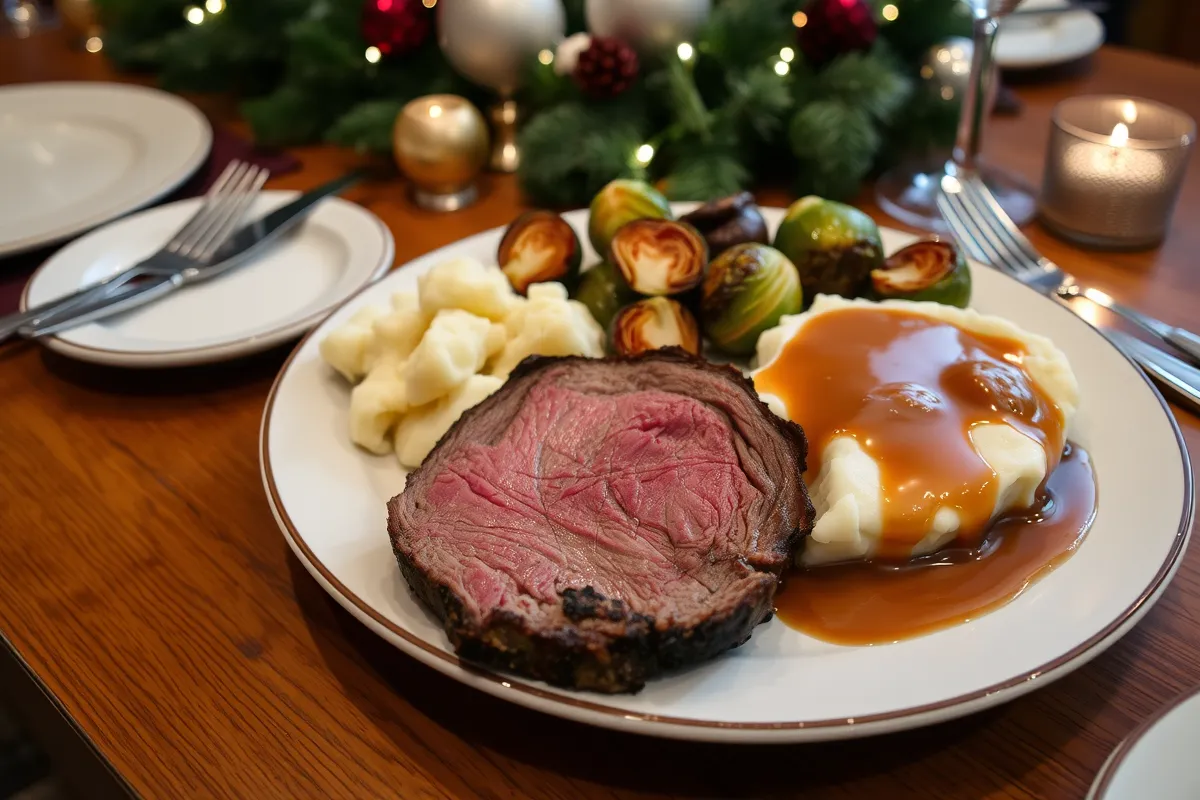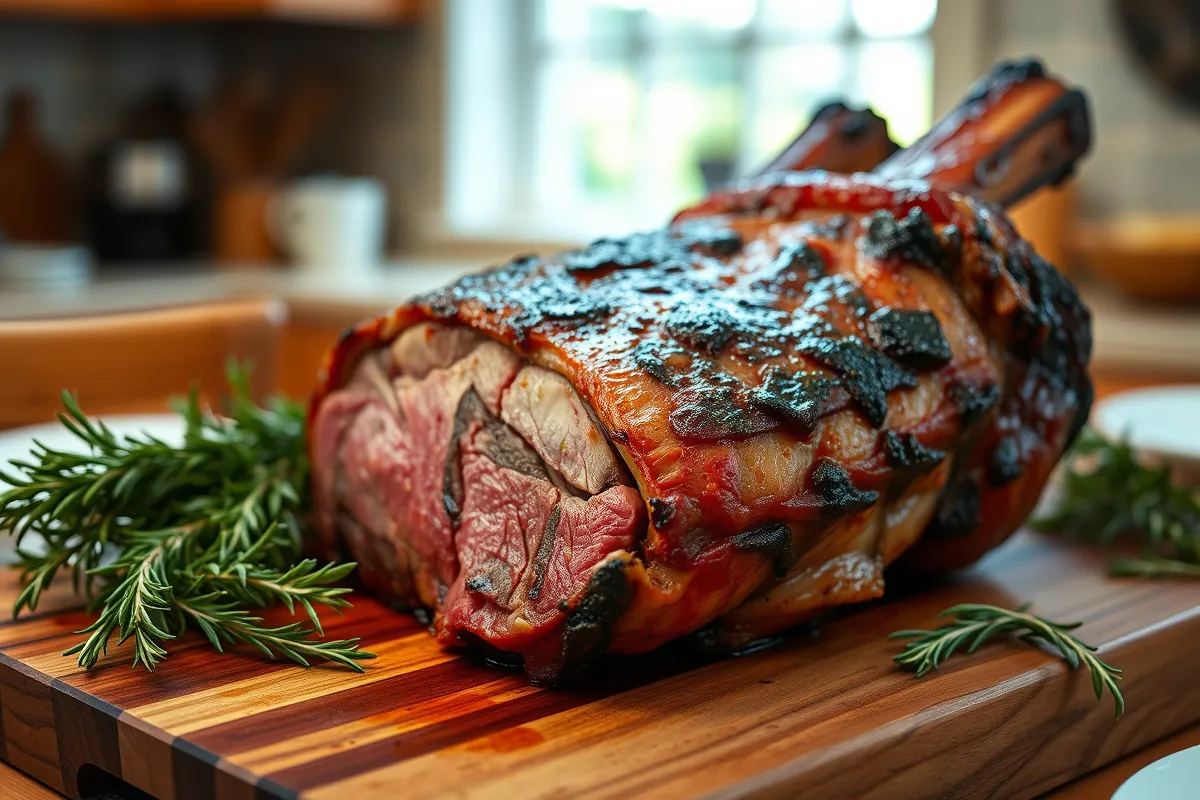Crafting the perfect prime rib recipe is no small feat. It’s a delicate balance of choosing the right cut, preparing it properly, and using just the right cooking techniques to ensure a tender, juicy result. Whether you’re planning a festive holiday meal or a special family dinner, understanding the ins and outs of cooking prime rib can turn you into a roast master. In this article, we’ll walk you through everything from selecting the best cut to innovative cooking methods, all while avoiding common pitfalls. Let’s dive into the world of prime rib perfection!
Understanding Prime Rib
What is Prime Rib?
Prime rib, also known as a standing rib roast, is one of the most coveted cuts of beef. Sourced from the primal rib section, this premium roast features excellent marbling and a rich beefy flavor. The name “standing rib roast” comes from the practice of roasting it upright, with the ribs acting as a natural rack. It’s a showstopper on any dinner table, perfect for occasions where you want to impress your guests.
But what sets prime rib apart from other cuts? Unlike sirloin or tenderloin, it boasts a higher fat content, contributing to its juicy tenderness. While often reserved for holidays like Christmas or Thanksgiving, there’s no reason you can’t enjoy this decadent cut year-round.
The Importance of Quality Meat
When it comes to the prime rib recipe, quality is king. Not all cuts are created equal, so it’s crucial to understand grading. USDA Prime, the highest grade, offers superior marbling and flavor but can be pricey. USDA Choice, a slightly less marbled option, is still a fantastic choice for those looking to save a bit without compromising too much on quality.
Bone-in or boneless? Both have their merits. A bone-in roast is often more flavorful, thanks to the bone’s ability to retain moisture and distribute heat evenly. On the other hand, a boneless roast is easier to carve and cook evenly, making it ideal for first-timers.
The Role of Marbling in Flavor and Texture
Ah, marbling—those beautiful streaks of white fat that run through the meat. Marbling is what makes prime rib the king of roasts. As it cooks, the fat melts, infusing the meat with rich flavor and keeping it juicy. When shopping for your roast, look for even marbling throughout the cut. Avoid pieces with large fat deposits concentrated in one area, as they can lead to uneven cooking.
In conclusion, understanding your prime rib recipe starts with knowing the meat itself. Select a high-quality roast with excellent marbling, and you’ll be well on your way to culinary glory. Now that we’ve covered the basics, it’s time to move on to the essentials of preparation!
Preparation Essentials
Prepping Your Prime Rib for Cooking
Preparation is the backbone of a successful prime rib recipe. Before you even think about turning on the oven, take time to prep your roast properly. Start by letting the meat come to room temperature. This simple step, which usually takes about two hours, ensures even cooking throughout.
Next, trim any excess fat if necessary, leaving a thin layer for flavor. A sharp knife is your best friend here, allowing you to remove only what’s needed without sacrificing the marbling. Some people prefer to tie their roast with butcher’s twine. This not only holds the shape of the meat but also helps it cook more evenly.
Seasoning the Prime Rib

The seasoning is where your creativity can shine. For a traditional approach, use a dry rub of kosher salt, freshly ground black pepper, garlic powder, and dried rosemary. Generously coat every inch of the meat, rubbing the spices into the surface to enhance flavor.
For something extra special, try a garlic and herb crust or a horseradish coating. These options add a flavorful twist to your prime rib recipe while maintaining its classic appeal. Don’t forget to let the seasoned roast sit for 30 minutes before cooking; this helps the flavors penetrate the meat.
Equipment and Tools You Need
To execute your recipe flawlessly, arm yourself with the right tools. A roasting pan with a rack is essential for keeping the meat elevated, ensuring even heat circulation. Invest in a quality meat thermometer to monitor the internal temperature accurately. Additionally, a sharp carving knife will make slicing effortless when it’s time to serve.
Cooking Methods
Oven Roasting: The Classic Method
Oven roasting is the go-to method for many when preparing a prime rib recipe. Start by preheating your oven to 450°F. Place the roast on a rack in a roasting pan, fat side up. Cook it at the high temperature for 15 minutes, then lower the heat to 325°F and continue roasting. This two-step process creates a beautiful crust while ensuring the interior cooks evenly.
Reverse searing is another excellent option. By cooking the roast at a low temperature first, then finishing at 500°F for a few minutes, you’ll achieve a perfectly crusted exterior without overcooking the center.
The No-Peek Method
For a nearly foolproof approach, try the no-peek method. After a quick sear at 500°F, turn off the oven and leave the roast inside for two hours. Resist the urge to open the door—it’s all about trapping the residual heat. The result? A perfectly cooked prime rib with minimal effort.
Grilling Prime Rib
When summer rolls around, grilling is a fantastic way to add smoky, flame-kissed flavor to your prime rib recipe. Use indirect heat to cook the roast slowly, then finish over direct heat to sear the exterior. Make sure to monitor the temperature closely, as grills can vary in heat distribution.
Smoking Prime Rib
For a bold, unique taste, consider smoking your roast. This method infuses the meat with deep, rich flavors that elevate any prime rib recipe. Hickory, oak, or applewood chips work beautifully here. Maintain a low and steady temperature, around 225°F, and let the smoke work its magic.
Modern Alternatives: Air Fryer and Sous Vide
Technology meets tradition with air fryers and sous vide techniques. An air fryer delivers a crisp crust in record time, while sous vide guarantees precision cooking with its temperature-controlled water bath. Both methods are great options for achieving consistent results with your prime rib recipe.
For more cooking inspiration, check out Grate Recipes for ideas to complement your prime rib masterpiece!
The Prime Rib 500 Rule and Variations
What is the Prime Rib 500 Rule?
The Prime Rib 500 Rule is a simple yet brilliant cooking technique for achieving the perfect roast. Here’s how it works: You preheat your oven to a blistering 500°F and cook your roast for five minutes per pound. After this initial burst, turn the oven off and leave the roast inside without opening the door for two hours.
This method relies on residual heat to finish cooking the meat, ensuring a tender and juicy interior with a beautifully seared crust. It’s a hands-off technique, making it ideal for beginners or anyone juggling multiple dishes during holiday prep.
Traditional Prime Rib Recipe
A traditional prime rib recipe sticks to classic flavors and straightforward preparation. Start by seasoning your roast generously with a mix of kosher salt, freshly cracked pepper, garlic powder, and dried thyme. After letting it rest at room temperature, roast it in the oven, following either the standard or reverse-sear method.
This tried-and-true approach highlights the natural flavors of the beef, allowing its rich marbling to shine. For a bit of extra flair, serve with a horseradish cream sauce or an au jus made from the pan drippings.
Serving and Pairing
Resting and Slicing Your Prime Rib
Patience pays off when it comes to carving your roast. After cooking, let your prime rib recipe rest for at least 20 minutes. This resting period allows the juices to redistribute, resulting in every slice being as tender and flavorful as possible.
When it’s time to carve, use a sharp knife and slice against the grain. Start from the rib side and work your way toward the wider end for consistent portions.
Best Side Dishes for Prime Rib

A great roast deserves equally stellar sides. Pair your prime rib recipe with buttery mashed potatoes, creamy spinach, or roasted Brussels sprouts for a balanced meal. Don’t forget the sauces—horseradish cream and a rich red wine au jus are classics that never disappoint.
If you’re looking for more meal ideas, check out recipes for savory sides and indulgent desserts at Grate Recipes. There’s no shortage of options to round out your feast!
FAQs About Prime Rib
How to Cook a Small Prime Rib Roast?
Cooking a smaller prime rib roast requires careful attention to timing and temperature, but the process is just as rewarding. Begin by seasoning the roast generously, just as you would with a larger cut. Preheat the oven to 450°F and cook the roast for about 15 minutes to develop a flavorful crust.
Afterward, reduce the oven temperature to 325°F and continue cooking until the internal temperature reaches your desired level of doneness. For a smaller cut, this could take as little as 1-2 hours, so keep a meat thermometer handy for accuracy. Adjusting the timing ensures that your prime rib recipe shines, no matter the size.
What is a Boneless Prime Rib Recipe?
A boneless prime rib recipe offers convenience without sacrificing flavor. Since there are no bones to contend with, it’s easier to slice and cooks slightly faster. To prepare, follow the same steps as a traditional roast: season generously, let it rest at room temperature, and roast until it reaches your preferred doneness.
The key difference lies in the presentation and slicing, as a boneless roast is straightforward to carve into even portions. Plus, it’s a great choice for those who prefer less hassle during meal prep.
Storage and Reheating Tips
Prime rib leftovers are a gift that keeps on giving, but proper storage is crucial. Wrap the meat tightly in foil or place it in an airtight container before refrigerating for up to 4-5 days. For longer storage, freeze the meat and thaw it overnight in the refrigerator before reheating.
When reheating, add a splash of beef broth to prevent the meat from drying out. Use a low oven temperature of around 300°F, and cover the meat loosely with foil to retain its moisture. Your prime rib recipe will taste just as delightful the second time around!
Prime Rib Troubleshooting and Tips
Common Mistakes to Avoid
Even seasoned cooks can encounter hiccups when tackling a prime rib recipe. One common misstep is overcooking the roast, which leads to a dry and chewy texture. Always use a meat thermometer to monitor the internal temperature, aiming for 120-125°F for rare and 130-135°F for medium-rare.
Another mistake is skipping the resting phase. Cutting into the roast too soon causes the juices to escape, leaving the meat less tender. Be patient and give the roast at least 20 minutes to rest.
Finally, under-seasoning can rob the dish of its full potential. Don’t be shy with the spices; a generous rub is key to enhancing the beef’s natural flavor.
Expert Tips for Consistent Results
Want to elevate your prime rib recipe game? Here are a few expert-approved tips:
- Invest in a quality meat thermometer: This tool ensures precision and takes the guesswork out of cooking.
- Bring the roast to room temperature before cooking: This promotes even cooking throughout the meat.
- Use a reverse sear: Start at a lower temperature, then finish with a high-heat blast for a crusty exterior.
By following these tips and avoiding common mistakes, you’ll serve up a roast that’s juicy, tender, and packed with flavor every time!
Prime Rib Leftovers
Creative Ways to Use Leftover Prime Rib
Leftovers from a prime rib recipe are culinary treasures. Rather than reheating and eating them as is, why not transform them into something new and exciting? Thinly sliced prime rib makes for a decadent sandwich. Layer the slices with caramelized onions, horseradish sauce, and a crusty roll for a meal that feels gourmet.
Another great idea is turning leftover prime rib into tacos. Dice the meat, season it with taco spices, and pair it with fresh toppings like guacamole, salsa, and lime. Or, take things a step further with a hearty prime rib ragu—perfect for spooning over pasta or mashed potatoes.
Storing Leftovers for Freshness
To keep your leftovers fresh, wrap the meat tightly in aluminum foil or place it in an airtight container. Store it in the refrigerator for up to five days, or freeze it for longer storage. When freezing, consider portioning it into smaller pieces so you can thaw only what you need.
When reheating, use a low oven temperature (about 300°F) and add a splash of beef broth to maintain the meat’s moisture. Whether you’re enjoying it as is or repurposing it into a new dish, leftover prime rib recipe creations are always a hit!
FAQs About Prime Rib
How to Cook a Small Prime Rib Roast?
Cooking a smaller prime rib roast requires careful attention to timing and temperature, but the process is just as rewarding. Begin by seasoning the roast generously, just as you would with a larger cut. Preheat the oven to 450°F and cook the roast for about 15 minutes to develop a flavorful crust.
Afterward, reduce the oven temperature to 325°F and continue cooking until the internal temperature reaches your desired level of doneness. For a smaller cut, this could take as little as 1-2 hours, so keep a meat thermometer handy for accuracy. Adjusting the timing ensures that your prime rib recipe shines, no matter the size.
What is a Boneless Prime Rib Recipe?
A boneless prime rib recipe offers convenience without sacrificing flavor. Since there are no bones to contend with, it’s easier to slice and cooks slightly faster. To prepare, follow the same steps as a traditional roast: season generously, let it rest at room temperature, and roast until it reaches your preferred doneness.
The key difference lies in the presentation and slicing, as a boneless roast is straightforward to carve into even portions. Plus, it’s a great choice for those who prefer less hassle during meal prep.
Storage and Reheating Tips
Prime rib leftovers are a gift that keeps on giving, but proper storage is crucial. Wrap the meat tightly in foil or place it in an airtight container before refrigerating for up to 4-5 days. For longer storage, freeze the meat and thaw it overnight in the refrigerator before reheating.
When reheating, add a splash of beef broth to prevent the meat from drying out. Use a low oven temperature of around 300°F, and cover the meat loosely with foil to retain its moisture. Your prime rib recipe will taste just as delightful the second time around!
Conclusion
A perfectly crafted prime rib recipe is more than just a meal—it’s an experience. From selecting the finest cut of beef to mastering cooking techniques like the Prime Rib 500 Rule or reverse sear, every step plays a role in creating a dish that delights the senses.
Whether you’re hosting a holiday gathering or preparing a special dinner for loved ones, prime rib has a way of turning any occasion into a memorable celebration. By understanding the importance of quality meat, embracing versatile cooking methods, and making the most of your leftovers, you can confidently serve a meal that’s both classic and unforgettable.
With this comprehensive guide at your fingertips, you’re now equipped to tackle any prime rib recipe with ease. So, roll up your sleeves, preheat that oven, and prepare to wow your guests with a roast that’s tender, juicy, and utterly delicious. Happy cooking!

